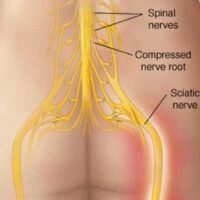If you have back pain or sciatic nerve pain, you’re not alone. Globally, one out of 10 people suffers from lower back pain, which is also the leading cause of job disability worldwide. In the US, back pain is particularly prevalent, with an estimated eight out of 10 Americans struggling with it at some point in their lives. Unfortunately, this condition has also contributed to the rise of painkiller addiction, as opioids are often prescribed for relief.
Back pain has become a major driver of opioid abuse in the US, surpassing heroin and cocaine in causing fatal overdoses. Those who also suffer from depression or anxiety face an even greater risk of opioid misuse, further complicating treatment outcomes.
Depression Combined with Back Pain Raises Risk of Drug Abuse

Research has shown that depression or anxiety can significantly increase the risk of opioid abuse among individuals with chronic lower back pain. In a study involving 55 patients with lower back pain and symptoms of depression or anxiety, participants were given either morphine, oxycodone, or a placebo for six months. The results revealed that those with higher levels of depression or anxiety not only experienced fewer benefits from the drugs but were also more prone to opioid abuse.
Key findings from the study included:
- 50% less improvement in back pain relief among those with higher anxiety or depression levels.
- 75% more opioid abuse in patients with these mental health symptoms.
This highlights the need to screen for depression and anxiety before prescribing opioids for back pain, as the risks often outweigh the benefits in these cases.
Common Back Pain Triggers
Identifying the cause of back pain can help prevent future episodes, although many people mistakenly attribute it to a single event. Recent research found that two-thirds of patients with back pain blamed a specific incident, such as lifting a heavy object. However, back pain often develops from factors that occur days or even weeks prior to the onset of discomfort.
Common back pain triggers include:
- Alcohol consumption
- Fatigue
- Being distracted during physical tasks
Accidents, sports injuries, poor posture, obesity, and inactivity (especially prolonged sitting) also contribute to chronic back pain. While understanding the trigger can help avoid recurrence, addressing the pain promptly is the most critical step.
What to Do When Back Pain Strikes
In most cases, back pain resolves on its own within two to four weeks, but you can take steps to speed up recovery. When pain strikes, it’s essential to relax both your body and mind. Applying ice, seeking acupuncture, or chiropractic care can be beneficial.
Instead of relying on prescription painkillers, consider using natural anti-inflammatory herbs like boswellia, curcumin, or ginger. Additionally, addressing emotional stress is crucial, as depression and anxiety can slow your body’s natural healing process.
Your brain and emotions play a significant role in your pain experience. The central nervous system stores pain memories, which can lead to persistent discomfort even after healing. Techniques like Emotional Freedom Technique (EFT) can help retrain the brain and alleviate pain.
Addressing Sciatic Nerve Pain
Sciatic nerve pain, or sciatica, occurs when the sciatic nerve is pinched in the lower back, often causing pain that radiates from the buttock down the thigh. Stretching exercises can help alleviate this pain by loosening the piriformis muscle, which, when too tight, can compress the sciatic nerve.
Here are four stretches that may provide relief:
- Piriformis stretch
- Seated hip stretch
- Pigeon pose
- Self-trigger point therapy using a tennis ball or foam roller
These exercises can help reduce tightness and alleviate pressure on the sciatic nerve, potentially reducing pain, tingling, and numbness in the leg.
Other Treatment Options for Sciatica
Several alternative treatments can help alleviate sciatic pain:
- Chiropractic Care: A 2010 study found that 60% of people with sciatica who received chiropractic care three times a week for four weeks experienced similar relief as those who underwent surgery.
- Acupuncture: Research published in the Journal of Traditional Chinese Medicine showed that 17 out of 30 patients with sciatica experienced complete relief with acupuncture.
- Yoga: While its effects on sciatica are less studied, yoga is beneficial for chronic back pain, with a study showing a 64% pain reduction after 16 weeks of practice.
- Pilates: A Spanish study found that older women with back pain who added Pilates to their physiotherapy routine experienced greater improvements in pain, balance, and reduced risk of falls.
- Trigger Point Massage: Applying pressure to trigger points in the piriformis, lower back muscles, and glutes can help release tension and reduce sciatic pain.
- Topical Preparations: Anti-inflammatory oils like St. John’s wort and cayenne pepper cream can be applied two to three times a day to relieve pain.
Avoiding Sitting May Be Part of the Long-Term Solution for Back Pain
While proper posture is important, avoiding prolonged sitting may be an even more effective strategy for preventing back pain. Many people find relief by reducing their sitting time and incorporating standing into their daily routine.
Standing can initially be uncomfortable if you’re accustomed to sitting for long periods, but reducing your sitting time from several hours a day to less than one hour can lead to significant improvements. For instance, after years of back pain, one individual found that cutting daily sitting time to under 30 minutes eliminated their discomfort.
If you have a desk job, consider investing in a stand-up desk and using a cushioned mat to stand on. Standing more often encourages gentle, continuous movement, which keeps your body functioning optimally. In contrast, sitting for extended periods can cause your muscles to become stiff and unresponsive.
Other Strategies for Preventing Back Pain
Preventing back pain is far easier than treating it, and there are many effective strategies to help maintain a pain-free life. In addition to those mentioned earlier, here are several more options:
- Exercise: Regular physical activity strengthens your spine-supporting muscles. Incorporate high-intensity workouts, balance exercises, and flexibility routines like yoga or Pilates.
- Mind Your Posture: Whether sitting or standing, maintain proper posture. When lifting, protect your back by avoiding awkward bending and evenly distributing weight across your feet.
- Vitamin D and K2: Optimizing these nutrients can help prevent bone softening, which can contribute to back pain.
- Grounding: Walking barefoot on natural surfaces like grass or sand can reduce inflammation, support your immune system, and strengthen your feet and arches.
- Psychological Factors: Emotional stress can exacerbate back pain. Addressing psychological factors through techniques like Emotional Freedom Technique (EFT) can aid in managing pain.
- K-Laser Treatment: Infrared laser therapy promotes tissue healing, reduces inflammation, and enhances circulation in painful areas.
- Stay Hydrated: Drinking plenty of water helps maintain the height of your spinal discs, keeping your spine flexible and reducing stiffness.
- Avoid Smoking: Smoking restricts blood flow to your spine, increasing the risk of disc degeneration.
- Sleep: Ensure adequate rest and consider your sleeping position. A firm mattress and sleeping on your side can help reduce back strain.
Empower Your Back

Preventing and managing back pain involves a holistic approach that includes proper posture, regular movement, and addressing both physical and emotional factors. Whether through stretching, chiropractic care, acupuncture, or simply reducing sitting time, there are many ways to alleviate discomfort and avoid recurrence. Remember, your overall health—physical, mental, and emotional—plays a critical role in how your body handles pain.
For long-term relief, incorporate strategies like exercise, adequate hydration, and optimizing your vitamin intake. By taking these steps, you can reduce your reliance on medications and empower your body to heal naturally.



